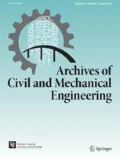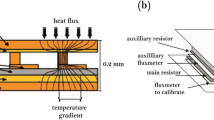Abstract
This paper reports on a comprehensive research on the performance of self-centering masonry walls (SMWs). A summary of an experimental study is presented. Finite element (FE) study was performed and verified against experimental results to predict the behaviour of SMWs. Using the verified FE modelling; Phase I of a parametric study was conducted aiming at developing a refined approach to better predict the ultimate capacity of SMWs. Subsequently, an equation was derived to estimate the length of the plastic hinge, which was then incorporated into an analytical method to determine the force–displacement behaviour of SMWs. In the analytical approach, displacement compatibility rather than strain compatibility was considered assuming the rocking mechanism of SMWs. Using experimental results; it was shown that the analytical approach could be used to effectively predict the force–displacement response of SMWs. The verified analytical method was then used to carry out Phase II of the parametric study, resulting in developing a new equation to estimate the depth of neutral axis depth. Using this new equation and plastic hinge expression developed in Phase I of the parametric study, a simplified expression was proposed to determine the flexural capacity of SMWs. Using both laboratory tests and numerical modelling analysis, it was indicated that both of the proposed refined and simplified method could significantly improve the strength prediction of SMWs.















Similar content being viewed by others
Abbreviations
- A ps s :
-
Pre-stressing steel area
- A ps i :
-
Pre-stressing steel area of the ith PT steel
- α,β :
-
Equivalent stress block parameters
- c :
-
Neutral axis depth
- d :
-
Effective depth of the section
- d i :
-
Distance from the extreme compression fiber to the ith pre-stressing steel
- d t :
-
Distance from the outermost tensile steel to the extreme compression fibre
- E m :
-
Module of elasticity of masonry
- E PS :
-
Young’s modulus of the pre-stressing steel
- f m0 :
-
Maximum compressive stress in masonry at decompression point
- f m j :
-
Masonry stress at distance xj from the neutral axis
- f m :
-
Masonry axial stress
- f’ m :
-
Masonry compressive strength
- f ps :
-
PT steel stress at ultimate flexural strength
- f ps i :
-
The ith pre-stressing steel stress at ultimate flexural strength
- f pu :
-
Ultimate rupture stress of pre-stressing steel
- f py :
-
Yield stress of pre-stressing steel
- f se :
-
Initial stress in the pre-stressing steel after losses
- f se i :
-
Effective stress in the ith pre-stressing steel after stress losses
- f yh :
-
Confining steel yield strength
- h w :
-
Wall height
- h″:
-
Lateral dimension of the confined core
- K :
-
Effective yield stiffness
- L pl :
-
Plastic hinge length
- L ps :
-
Unbonded length of the pre-stressing steel
- L w :
-
Wall length
- M, M n :
-
Moment capacity of the wall
- N :
-
Gravity load
- s h :
-
Longitudinal spacing of confining steel
- t w :
-
Thickness of the wall
- T :
-
Total tension force
- T i :
-
Tension force of the ith pre-stressing steel
- T FEM :
-
Total PT force at peak load obtained from finite element approach
- T EXP :
-
Total PT force at peak load from experimental study
- V :
-
Lateral force corresponding to wall rotation θ
- V 0 :
-
Base shear at decompression point
- V FEM :
-
Lateral strength of the wall obtained using finite element approach
- V EXP :
-
Lateral strength of the wall from experimental study
- V EQN :
-
Lateral strength of the wall obtained using design equations
- Δ :
-
Wall top displacement due to wall rotation
- Δ 0 :
-
Wall top displacement at decompression point
- Δ f :
-
Total wall top displacement
- Δ i :
-
Elongation of the ith pre-stressing steel
- ε 0 :
-
Maximum compressive strain in concrete at decompression point
- ε m :
-
Masonry strain at the extreme compressive fiber
- ε m j :
-
Masonry strain at distance xj from the neutral axis
- ε mu :
-
Ultimate masonry compressive strain
- ε pu :
-
Ultimate strain of pre-stressing steel
- ε py :
-
Yield strain of pre-stressing steel
- ε se i :
-
Initial strain in the ith pre-stressing steel after immediate losses
- θ :
-
Wall rotation
- θ 0 :
-
Wall rotation at decompression point
- θ m :
-
Wall rotation at ultimate flexural strength
- ρ s :
-
Volumetric ratio of the confining steel
- σ ps i :
-
Stress in the ith pre-stressing steel
- φ 0 :
-
Maximum wall curvature at decompression point
References
Priestley MN, Tao JR. Seismic response of precast prestressed concrete frames with partially debonded tendons. PCI J. 1993;38:58–69.
Ricles JM, Sause R, Garlock MM, Zhao C. Posttensioned seismic-resistant connections for steel frames. J Struct Eng. 2001;127:113–21.
Buchanan A, Deam B, Fragiacomo M, Pampanin S, Palermo A. Multi-storey prestressed timber buildings in New Zealand. Struct Eng Int. 2008;18:166–73.
Priestley M, Sritharan S, Conley JR, Pampanin S. Preliminary results and conclusions from the PRESSS five-story precast concrete test building. PCI J. 1999;44:42–67.
Ismail N, Ingham JM. Cyclic out-of-plane behavior of slender clay brick masonry walls seismically strengthened using posttensioning. J Struct Eng. 2012;138:1255–66.
Laursen PT, Ingham JM. Structural testing of enhanced post-tensioned concrete masonry walls. Aci Struct J. 2004;101:852–62.
Wight GD, Ingham JM. Tendon stress in unbonded posttensioned masonry walls at nominal in-plane strength. J Struct Eng. 2008;134:938–46.
Bean Popehn JR, Schultz AE, Drake CR. Behavior of slender, posttensioned masonry walls under transverse loading. J Struct Eng. 2007;133:1541–50.
MSJC. Building code requirements for masonry structures. TMS (The Masonry Society), ACI 530/ASCE 5, TMS 402, American Concrete Institute, Detroit; 2013.
Hassanli R. Behavior of unbonded post-tensioned masonry walls: PhD Thesis, University of South Australia, South Australia, Australia; 2015.
Hassanli R, ElGawady M, Mills J. Experimental investigation of in-plane cyclic response of unbonded posttensioned masonry walls. J Struct Eng. 2016;142:04015171.
Priestley M, Calvi G, Kowalsky M. Displacement-based seismic design of structures Pavia. Italy: IUSS Press; 2007.
Malvar LJ, Crawford JE, Wesevich JW, Simons D. A plasticity concrete material model for DYNA3D. Int J Impact Eng. 1997;19:847–73.
Priestley M, Elder D. Stress–strain curves for unconfined and confined concrete masonry. ACI J Proc. 1983;80(3):192–201.
Hassanli R, ElGawady M, Mills J. Effect of dimensions on the compressive strength of concrete masonry prisms. Adv Civil Eng Mater. 2015;4:175–201.
Abasi A, Hassanli R, Vincent T, Manalo A. Influence of prism geometry on the compressive strength of concrete masonry. Constr Build Mater. 2020;264:120182.
Laursen PPT. Seismic analysis and design of post-tensioned concrete masonry walls: PhD Thesis, Department of Civil and Environmental Engineering. University of Auckland. Auckland, New Zealand; 2002.
Hassanli R, ElGawady M, Mills J. In-plane flexural strength of unbonded post-tensioned concrete masonry walls. Eng Struct. 2017;136:245–60.
Paulay T, Priestly MJN. Seismic design of reinforced concrete and masonry buildings. Wiley; 2009.
Hassanli R, ElGawady M, Mills J. Simplified approach to predict the flexural strength of unbonded post-tensioned masonry walls. J Struct Eng (ASCE). 2015;142:255–71.
Hassanli R, ElGawady M, Mills J. Strength and seismic performance factors of posttensioned masonry walls. J Struct Eng. 2015. https://doi.org/10.1061/(ASCE)ST.1943-541X.0001272.:04015038.
Rosenboom OA, Kowalsky MJ. Reversed in-plane cyclic behavior of posttensioned clay brick masonry walls. J Struct Eng. 2004;130(5):787–98.
Priestley M, Calvi G, Kowalsky M. Direct displacement-based seismic design of structures. NZSEE Conference; 2007.
Rosenboom OA. Post-tensioned clay brick masonry walls for modular housing in seismic regions: M.S. Thesis, North Carolina State University. Raleigh, NC, US; 2002.
TMS 402/602-16 Building Code Requirements and Specifications for Masonry Structures, The Masonry Society, America, 2016.
Author information
Authors and Affiliations
Corresponding author
Ethics declarations
Conflict of interest
The authors declare that they have no conflict of interest.
Ethical approval
This article does not contain any studies with human participants or animals performed by any of the authors.
Additional information
Publisher's Note
Springer Nature remains neutral with regard to jurisdictional claims in published maps and institutional affiliations.
Rights and permissions
About this article
Cite this article
Hassanli, R. In-plane flexural response of self-centering masonry walls (SMWs). Archiv.Civ.Mech.Eng 21, 63 (2021). https://doi.org/10.1007/s43452-021-00215-5
Received:
Revised:
Accepted:
Published:
DOI: https://doi.org/10.1007/s43452-021-00215-5




